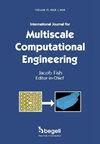APPLICATION OF SKELETAL BIOMECHANICS TO STRUCTURAL SYSTEMS
IF 1.4
4区 工程技术
Q2 ENGINEERING, MULTIDISCIPLINARY
International Journal for Multiscale Computational Engineering
Pub Date : 2023-12-01
DOI:10.1615/intjmultcompeng.2023050245
引用次数: 0
Abstract
The concept of green construction enables a revolutionary change in construction sector in terms of design, production, and management. One such method is introducing the concept of biomimicry. Biomimicry is utilized in the field of design to solve problems. This paper mainly discusses about the mimicking of human skeleton for structural design. The idea is mimicking humerus bone as a tension member and femur bone as a compression member. The optimized members of compression and tension (strut and tie) were put together to form the mimicked king post truss analytically with the conventional cross section truss with average diameter, maximum diameter, and equivalent self-weight to the members of mimicked truss and experimentally testing with non-destructive test and point load test.The result shows that the ultimate load carrying capacity of critical compression member and tension member was 846.16 kN and 1952 kN respectively. Whereas, the achieved load was 780.30 kN and 1729 kN.Also, the ratio of analytical stiffness to self-weight is 21.83 mm-1 and the ratio of experimental stiffness to self-weight was 19.15 mm-1. Therefore, from the results it was observed that the equivalent results for mimic truss can be achieved in a truss which is modeled of equivalent self-weight. Hence the development and use of structural elements using biomimicry is feasible and that will lead to economic, green and energy efficient structures.骨骼生物力学在结构系统中的应用
绿色建筑的概念使建筑行业在设计、生产和管理方面发生了革命性的变化。其中一种方法就是引入生物模拟概念。仿生学在设计领域被用来解决问题。本文主要讨论模仿人体骨骼进行结构设计。其思路是模仿肱骨作为受拉构件,股骨作为受压构件。结果表明,临界受压构件和受拉构件的极限承载力分别为 846.16 kN 和 1952 kN。此外,分析刚度与自重之比为 21.83 mm-1,实验刚度与自重之比为 19.15 mm-1。因此,从结果中可以看出,模拟桁架的等效结果可以通过自重等效的桁架模型来实现。因此,利用仿生学开发和使用结构元素是可行的,这将带来经济、绿色和节能的结构。
本文章由计算机程序翻译,如有差异,请以英文原文为准。
求助全文
约1分钟内获得全文
求助全文
来源期刊
CiteScore
3.40
自引率
14.30%
发文量
44
审稿时长
>12 weeks
期刊介绍:
The aim of the journal is to advance the research and practice in diverse areas of Multiscale Computational Science and Engineering. The journal will publish original papers and educational articles of general value to the field that will bridge the gap between modeling, simulation and design of products based on multiscale principles. The scope of the journal includes papers concerned with bridging of physical scales, ranging from the atomic level to full scale products and problems involving multiple physical processes interacting at multiple spatial and temporal scales. The emerging areas of computational nanotechnology and computational biotechnology and computational energy sciences are of particular interest to the journal. The journal is intended to be of interest and use to researchers and practitioners in academic, governmental and industrial communities.

 求助内容:
求助内容: 应助结果提醒方式:
应助结果提醒方式:


